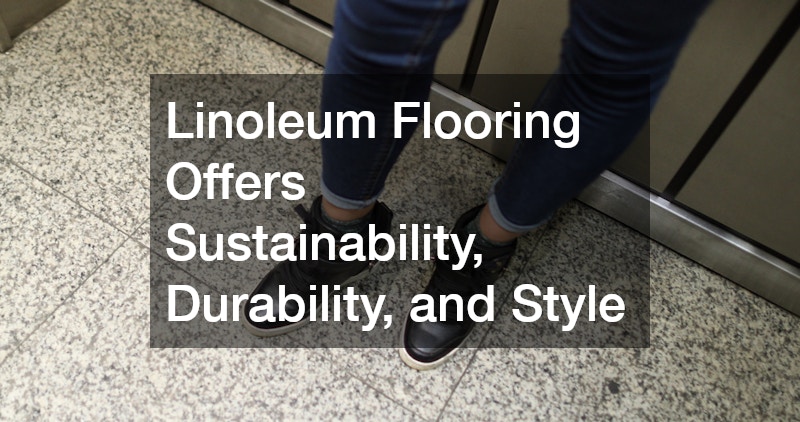Linoleum flooring has been a popular choice for many homeowners seeking an eco-friendly and durable flooring option. In this article, we will explore the advantages and disadvantages of installing linoleum in your home, addressing common questions and concerns.
What are the Benefits of Linoleum Flooring?
Sustainability and Eco-Friendliness
Linoleum is made from natural, renewable materials such as linseed oil, wood flour, and cork dust, making it an environmentally responsible flooring option. Its biodegradability ensures that at the end of its life cycle, it can return safely to the earth without contributing to landfill waste.
This flooring choice boasts a significantly lower carbon footprint compared to synthetic flooring materials, which often rely on petroleum-based components. By choosing linoleum, homeowners can reduce their environmental impact while enjoying a stylish and functional flooring solution.
Another notable advantage is that linoleum is hypoallergenic, which contributes to improved indoor air quality. Its natural composition does not emit harmful VOCs, creating a healthier home environment for those with respiratory sensitivities.
Durability and Longevity
Linoleum flooring is renowned for its remarkable durability, capable of withstanding heavy foot traffic in both residential and commercial settings. When properly maintained, linoleum can last 20 to 40 years, making it a long-lasting investment for homeowners.
Linoleum is resistant to scratches and dents, ensuring that it maintains its aesthetic appeal even in high-traffic areas such as kitchens and hallways. Its resilience to wear makes it an ideal candidate for families and pet owners seeking a robust flooring solution.
In addition to being resilient to physical wear, linoleum is naturally resistant to the growth of mold and bacteria. This quality contributes to a healthier living environment and requires less frequent cleaning, making it a practical and time-saving choice.
Are There Downsides to Linoleum Flooring?
Moisture Sensitivity
One of the primary drawbacks of linoleum is its sensitivity to moisture, which can cause the material to warp or become discolored if not adequately protected. As a result, it may not be suitable for areas of the home such as bathrooms or basements where high humidity is prevalent.
To overcome this limitation, homeowners can apply a protective sealant during installation, helping to mitigate potential moisture damage. However, this does add an extra step to the installation process and may require additional maintenance to ensure ongoing protection.
Moreover, ongoing vigilance is necessary to promptly address any spills or leaks that could compromise the integrity of the linoleum. Regular inspection and maintenance are crucial to preserving the flooring’s appearance and functionality over time.
Installation and Maintenance Challenges
Installing linoleum flooring can be more complex than some other flooring options, often requiring professional expertise to achieve optimal results. Incorrect installation can lead to issues such as uneven surfaces or gaps between tiles, impacting the floor’s performance and longevity.
Despite its ease of cleaning, linoleum does require periodic refinishing to maintain its protective surface and visual appeal. Without this maintenance, the floor may become dull or more susceptible to stains from everyday use.
While these challenges may deter some homeowners, those willing to invest time and resources into proper installation and upkeep can enjoy the benefits of linoleum for decades. Weighing these factors is essential to making an informed decision about this flooring material.
How Does Linoleum Compare to Other Flooring Options?
Cost Comparison
When compared to other flooring options such as vinyl or hardwood, linoleum presents a cost-effective choice without compromising on quality or performance. Its initial purchase price is often lower than that of hardwood, while offering comparable durability and aesthetics.
In addition to its competitive pricing, linoleum’s long lifespan contributes to its overall value, reducing the need for frequent replacements that can add up over time. Homeowners seeking a budget-friendly flooring option may find linoleum to be an attractive solution.
While vinyl may offer similar price points and ease of installation, linoleum outshines in environmental benefits, making it a more sustainable option. Choosing linoleum allows homeowners to balance cost savings with eco-consciousness.
Aesthetic Versatility
Linoleum offers a wide range of design and color options, allowing it to complement various decor styles from modern to traditional. This versatility makes it a popular choice for homeowners seeking to customize their living spaces with unique patterns or vibrant hues.
Unlike some other flooring materials, linoleum can be easily customized or combined, providing endless design possibilities to suit individual preferences. Its adaptable nature ensures it can meet the aesthetic demands of diverse interior designs.
The ability to create one-of-a-kind patterns or replicate the textures of natural stone or wood enhances linoleum’s appeal, distinguishing it from more conventional flooring choices. This aesthetic flexibility can significantly impact the overall ambiance and value of a home.
Linoleum flooring presents multiple advantages, including sustainability, durability, and aesthetic versatility. However, potential downsides such as moisture sensitivity and installation challenges should be carefully weighed by homeowners.
By considering personal preferences, specific home requirements, and budget constraints, homeowners can make an informed decision on whether linoleum flooring aligns with their vision and lifestyle needs. Balancing the pros and cons is essential to creating a harmonious and functional home environment.

